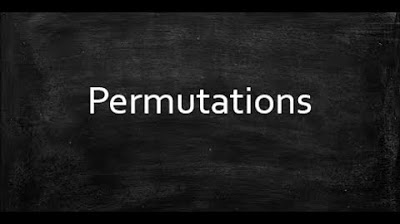PERMUTASI & FAKTORIAL | Kelas 12
Summary
TLDRThis video tutorial explains factorials and permutations, fundamental concepts in mathematics for high school students. The video covers the definition of factorials, including examples with numbers like 7! and 5!, and their application in various problems. It then dives into permutations, highlighting the formula for general and circular permutations, along with examples. The tutorial also tackles scenarios involving repeated elements in permutations and the importance of considering special conditions, such as when objects are adjacent. Overall, the video provides comprehensive insights into these concepts through clear explanations and practical examples.
Takeaways
- 😀 Factorial is the multiplication of natural numbers, represented by the symbol 'n!'. For example, 7! means multiplying all integers from 1 to 7.
- 😀 0! (zero factorial) is defined as 1, which is important when calculating factorials in certain mathematical formulas.
- 😀 A factorial expression like 2! * 3! represents the product of 2! and 3!, which simplifies to 1 * 2 and 1 * 2 * 3, respectively.
- 😀 Permutation refers to the arrangement of objects, considering the order. The formula for permutations is P(n, r) = n! / (n - r)!.
- 😀 When solving for permutations with identical elements, the formula is adjusted to account for repetitions, such as P = n! / (p1! * p2! * ...).
- 😀 The formula for circular permutations (where objects are arranged in a circle) is P_s = (n - 1)!.
- 😀 For problems involving multiple identical objects, such as repeated letters in a word, use the formula P = n! / (repetitions of each identical object).
- 😀 When calculating the number of distinct arrangements of the word 'Melayu' (6 letters, all different), we use 6! to get the result of 720 arrangements.
- 😀 If the number of available positions equals the number of elements to be arranged (e.g., 5 students, 5 spots), the number of permutations is simply 5!, which equals 120.
- 😀 In circular permutations with constraints (e.g., a family of 6 where the parents must sit together), treat the parents as one unit and apply the circular permutation formula to the remaining elements.
Q & A
What is the definition of a factorial?
-A factorial is the product of all positive integers from 1 up to the number n. It is denoted as n!, for example, 5! = 5 × 4 × 3 × 2 × 1.
How do you calculate a factorial like 7!?
-To calculate 7!, you multiply all integers from 1 to 7: 7! = 7 × 6 × 5 × 4 × 3 × 2 × 1 = 5040.
What does the expression 5! / 3! represent?
-The expression 5! / 3! represents the division of the factorial of 5 by the factorial of 3. You first calculate 5! = 5 × 4 × 3 × 2 × 1 and 3! = 3 × 2 × 1, and then divide the results, which simplifies to 5 × 4 = 20.
What is the value of 0! and why?
-The value of 0! is defined as 1. This is a mathematical convention to ensure the consistency of formulas and combinatorial calculations.
What is a permutation?
-A permutation is an arrangement of objects where the order of the objects matters. For example, arranging 3 objects from a set of 5 objects can result in different arrangements depending on the order.
What is the formula for general permutations?
-The formula for general permutations is P(n, r) = n! / (n - r)!, where n is the total number of objects, and r is the number of objects being arranged.
How do you calculate permutations when some objects are identical?
-When some objects are identical, the formula becomes P = n! / (p1! × p2! × ...), where p1, p2, etc. represent the counts of each identical object.
What is the formula for circular permutations?
-The formula for circular permutations is P_circular = (n - 1)!, where n is the number of objects arranged in a circle. This accounts for the fact that rotating the circle does not create a new permutation.
What is the number of different arrangements that can be made with the word 'Melayu'?
-The number of different arrangements for the word 'Melayu' is 720, because the word contains six unique letters. The calculation is 6!, which equals 720.
How do you calculate permutations when objects are repeated, such as in the word 'matematika'?
-For the word 'matematika', the number of permutations is calculated using the formula P = n! / (p1! × p2! × ...), where n is the total number of objects, and p1, p2, etc., represent the counts of each repeated object. For 'matematika', this results in 10! / (3! × 2! × 2!) = 151202.
What is the difference between permutations with and without repetition?
-In permutations with repetition, some objects can appear more than once, while in permutations without repetition, each object can only appear once in the arrangement. The formulas differ accordingly, with repetition requiring adjustments for identical objects.
Outlines

This section is available to paid users only. Please upgrade to access this part.
Upgrade NowMindmap

This section is available to paid users only. Please upgrade to access this part.
Upgrade NowKeywords

This section is available to paid users only. Please upgrade to access this part.
Upgrade NowHighlights

This section is available to paid users only. Please upgrade to access this part.
Upgrade NowTranscripts

This section is available to paid users only. Please upgrade to access this part.
Upgrade NowBrowse More Related Video

ILLUSTRATING PERMUTATIONS OF OBJECTS | MATH 10 | MELCS Q3 - WEEK 1 | TEACHER REIMAR

Materi Kombinatorika SMA - Teori Filling Slots, Kombinasi, Peluang, Permutasi Siklis dll Part #1

Faktorial, permutasi, dan kombinasi

KOMBINASI | Matematika Wajib Kelas XII

FAKTORIAL, PERMUTASI, DAN KOMBINASI | Video Pembelajaran Matematika

Permutations
5.0 / 5 (0 votes)